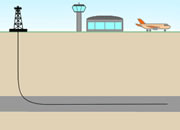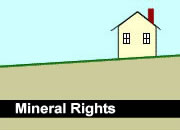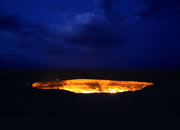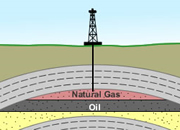| Israel and Jordan Oil Shale |
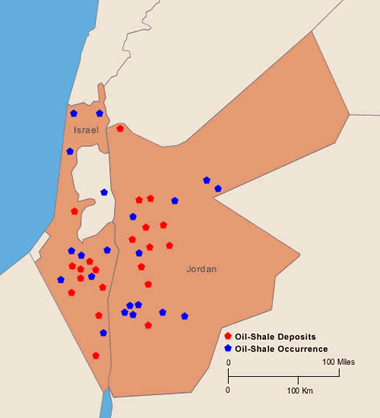
Map of oil shale deposits in Israel (locations after Minster, 1994). Also, oil-shale deposits in Jordan (locations after Jaber and others, 1997; and, Hamarneh, 1998). Click to enlarge map.
Israel
Twenty marinite deposits of Late Cretaceous age have been identified in Israel (fig. 10; Minster, 1994), containing about 12 billion tons of oil-shale reserves with an average heating value of 1,150 kcal/kg of rock and an average oil yield of 6 weight percent. Thicknesses ranging from 35 to 80 m were reported by Fainberg in Kogerman (1996, p. 263) and 5 to 200 m by PAMA, Ltd. (2000?). The organic content of the oil shales is relatively low, ranging from 6 to 17 weight percent, with an oil yield of only 60 to 71 l/t. The moisture content is high (~20 percent) as is the carbonate content (45 to 70 percent calcite) and the sulfur content (5 to 7 weight percent) (Minster, 1994). Some of the deposits can be mined by open-pit methods. A commercially exploitable bed of phosphate rock, 8 to 15 m thick, underlies the oil shale in the Mishor Rotem open-pit mine.
Utilizing oil shale from the Rotem-Yamin deposit, about 55 tons of oil shale per hour were burned in a fluidized bed boiler to power a steam turbo-generator in a 25-megawatt experimental electric power plant operated by PAMA Company. The plant began operation in 1989 (Fainberg and Hetsroni, 1996) but is now closed. The grade of the Rotem oil shale is not uniform; the heating values range from 650 to 1200 kcal/kg.
Jordan
Jordan has few resources of oil and gas and no commercial deposits of coal. However, there are about 26 known deposits of oil shale, some of which are large and relatively high-grade (Jaber and others, 1997; Hamarneh, 1998, p. 2). The eight most important of these are the Juref ed Darawish, Sultani, Wadi Maghar, El Lajjun, Attarat Umm Ghudran, Khan ez Zabib, Siwaga, and Wadi Thamad deposits. These eight deposits are located in west central Jordan within 20 to 75 km east of the Dead Sea. The El Lajjun, Sultani, and Juref ed Darawish have been the most extensively explored by boreholes and many samples have been analyzed. Table 5 summarizes some of the geologic and resource data for the eight deposits.
The Jordanian oil-shale deposits are marinites of Late Cretaceous (Maastrichtian) to early Tertiary age. A number of deposits are in grabens and some may prove to be parts of larger deposits, such as the Wadi Maghar deposit that is now considered to be the southern extension of the Attarat Umm Ghudran deposit. The deposits listed in table 5 are at shallow depths, in essentially horizontal beds. As much as 90 percent of the oil shale is amenable to open-pit mining (Hamarneh, 1998, p. 5). The overburden consists of unconsolidated gravel and silt containing some stringers of marlstone and limestone and, in some areas, basalt. Overall, the oil shales thicken northward toward the Yarmouk deposit near the northern border of Jordan where the latter apparently extends into Syria and may prove to be an exceptionally large deposit-underlying several hundred square kilometers and reaching 400 m in thickness (Tsevi Minster, 1999, written commun.).
The oil shales in central Jordan are in the marine Chalk-Marl unit, which is underlain by phosphatic limestone and chert of the Phosphorite unit. The oil shales are typically brown, gray, or black and weather to a distinctive light bluish-gray. The moisture content of the oil shale is low (2 to 5.5 weight percent), whereas comparable deposits of oil shale in Israel have a much higher moisture content of 10 to 24 percent (Tsevi Minster, 1999, written commun.). Calcite, quartz, kaolinite, and apatite make up the major mineral components of the El Lajjun oil shale, along with small amounts of dolomite, feldspar, pyrite, illite, goethite, and gypsum. The sulfur content of Jordanian oil shale ranges from 0.3 to 4.3 percent. The sulfur content of shale oil from the Jurf ed Darawish and the Sultani deposits is high, 8 and 10 percent, respectively. Of interest is the relatively high metal content of the oil shales from the Jurf el Darawish, Sultani, and El Lajjun deposits, notably Cu (68-115 ppm), Ni (102-167 ppm), Zn (190-649 ppm), Cr (226-431 ppm), and V (101-268 ppm) (Hamarneh, 1998, p. 8). Phosphate rock underlies the El Hasa deposit.
Surface water for oil-shale operations is scarce in Jordan; therefore, groundwater will need to be tapped for oil-shale operations. A shallow aquifer that underlies the El Lajjun deposit, and provides fresh water to Amman and other municipalities in central Jordan, is too small in capacity to also meet the demands of an oil-shale industry. A deeper aquifer in the Kurnub Formation, 1,000 m below the surface, may be capable of providing an adequate supply of water, but this and other potential ground-water sources need further study.

